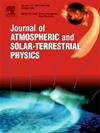Evaluation of machine learning models to estimate particulate matter (2.5) in oil producing Arab countries: Kuwait as a case study
IF 1.9
4区 地球科学
Q3 GEOCHEMISTRY & GEOPHYSICS
Journal of Atmospheric and Solar-Terrestrial Physics
Pub Date : 2025-05-02
DOI:10.1016/j.jastp.2025.106536
引用次数: 0
Abstract
Air pollution is one of the most serious environmental issues facing the State of Kuwait. The environment and the population's health depend on the state's ability to maintain air quality. Most air pollution is caused by the increasing population, increased human activities, and increased vehicle ownership. Reducing pollution and preserving the environment therefore depends on managing environmental pollutants. This research aimed to create a reliable method for assessing the concentrations of Particulate Matter 2.5 (PM2.5; i.e., particles with a diameter less than 2.5 μm (μm)), one of the most harmful pollutants. Most of the existing studies on air quality prediction in Kuwait or similar areas face some challenges in the model accuracy, lack of datasets, and environmental variation. To address these challenges, four machine learning models: neural network models, support vector machine algorithms, generalized additive models, and random forests were used. The models were trained in four scenarios: daily or monthly data and data divided by city or aggregated. The results showed that the random forest model outperformed the others in predicting PM2.5 concentration in all scenarios, with Coefficient of determination (R2) over 0.85, root mean squared error (RMSE) under 6.25 μg/m3 and mean absolute error (MAE) under 6.17 μg/m3. This study can be used as a guide for choosing the best model for estimating daily PM2.5 concentrations in Kuwait and other places with the same climate.
评估阿拉伯产油国估计颗粒物(2.5)的机器学习模型:以科威特为例研究
空气污染是科威特国面临的最严重的环境问题之一。环境和人民的健康取决于国家维持空气质量的能力。大多数空气污染是由人口增长、人类活动增加和车辆拥有量增加造成的。因此,减少污染和保护环境取决于管理环境污染物。这项研究旨在创建一种可靠的方法来评估PM2.5的浓度;即直径小于2.5 μm (μm)的颗粒,是最有害的污染物之一。现有的科威特或类似地区的空气质量预测研究大多面临着模型精度、数据集缺乏和环境变化等方面的挑战。为了解决这些挑战,使用了四种机器学习模型:神经网络模型、支持向量机算法、广义加性模型和随机森林。这些模型在四种情况下进行训练:每日或每月数据以及按城市划分或汇总的数据。结果表明,随机森林模型预测PM2.5浓度在所有情景下均优于其他模型,决定系数(R2)大于0.85,均方根误差(RMSE)小于6.25 μg/m3,平均绝对误差(MAE)小于6.17 μg/m3。本研究可以作为选择最佳模型来估算科威特和其他具有相同气候的地方的PM2.5日浓度的指南。
本文章由计算机程序翻译,如有差异,请以英文原文为准。
求助全文
约1分钟内获得全文
求助全文
来源期刊

Journal of Atmospheric and Solar-Terrestrial Physics
地学-地球化学与地球物理
CiteScore
4.10
自引率
5.30%
发文量
95
审稿时长
6 months
期刊介绍:
The Journal of Atmospheric and Solar-Terrestrial Physics (JASTP) is an international journal concerned with the inter-disciplinary science of the Earth''s atmospheric and space environment, especially the highly varied and highly variable physical phenomena that occur in this natural laboratory and the processes that couple them.
The journal covers the physical processes operating in the troposphere, stratosphere, mesosphere, thermosphere, ionosphere, magnetosphere, the Sun, interplanetary medium, and heliosphere. Phenomena occurring in other "spheres", solar influences on climate, and supporting laboratory measurements are also considered. The journal deals especially with the coupling between the different regions.
Solar flares, coronal mass ejections, and other energetic events on the Sun create interesting and important perturbations in the near-Earth space environment. The physics of such "space weather" is central to the Journal of Atmospheric and Solar-Terrestrial Physics and the journal welcomes papers that lead in the direction of a predictive understanding of the coupled system. Regarding the upper atmosphere, the subjects of aeronomy, geomagnetism and geoelectricity, auroral phenomena, radio wave propagation, and plasma instabilities, are examples within the broad field of solar-terrestrial physics which emphasise the energy exchange between the solar wind, the magnetospheric and ionospheric plasmas, and the neutral gas. In the lower atmosphere, topics covered range from mesoscale to global scale dynamics, to atmospheric electricity, lightning and its effects, and to anthropogenic changes.
 求助内容:
求助内容: 应助结果提醒方式:
应助结果提醒方式:


